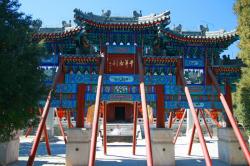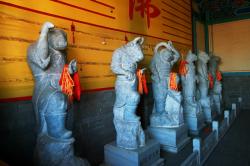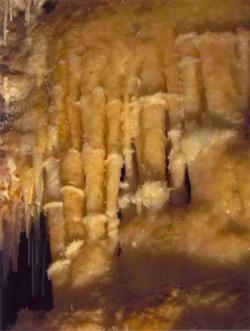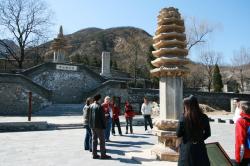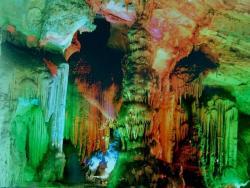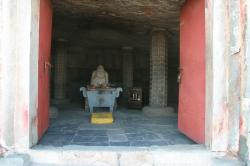-
Yunju Temple (literally Cloud-dwelling Temple) is a Buddhist shrine and an important heritage site of China in Fangshan, southwest of Beijing.
The temple is famous for three things: its groups of pagodas built in Tang and Liao Dynasties, stone scriptures (Buddhist scriptures inscribed on stone tablets , totally 4,278 integral stone scripture tablets stored in caves), and unearthed Buddha’s flesh sariras (pearl-like Buddha relics) .
The Buddha’s flesh relics in Yunju Temple is one of the three original Buddha’s relics in China, together with finger relics in Famen Temple in Shaanxi and teeth relics in Badachu park of Beijing.
The pagodas at Yunju Temple in Beijing are characterized by long history, large number, special shapes, and exquisite sculptures. Seven of them, dating from Tang Dynasty, are called merits-and-virtues pagodas (The monastery has the largest number of such pagodas in China). Sculptures on them are classics of the art in Tang Dynasty. The north pagoda, dating from Liao Dynasty, is shaped in a way that is rarely found in other ancient pagodas in China. The brick sculptures of Liao-dynasty dances are important for research into dances in that dynasty.
The stone scriptures and the caves for their storage started to be made in the early 6th century, in the years of Daye in Sui Dynasty, by Jingwan, a monk who came from Zhiquan Monastery. In case persecutions of Buddhism by two emperors, namely Taiwu in the northern Wei Dynasty and Wu in the northern Zhou Dynasty, should recur, and also to fulfill the deathbed behest of Master Huisi, his teacher, he decided to carve all scriptures on stone and store them in caves. The work went on for 1,039 years through six dynasties-Sui, Tang, Liao, Jin, Yuan, and Ming, and so far a total of 14,278 well-reserved stone inscriptions were found, 1,122 scriptures in 3,572 volumes.
The practice of inscribing scriptures on stone tablets, the quality of the editions used, the number of scriptures, and the duration of the work are all but unparalleled in China and any other country of the world.
Explore the Yunju (literally Cloud Dwelling) Temple and some beautiful thousand-year old pagodas at the foot of the mountain. View some stored Buddhist scriptures - 14,278 carved stone slabs dating back to over a thousand year.
Then we continue to explore another attraction in Fangshan District - the Silver Fox Cave. You will see the spectacular sights in the 4,500m long karst cave with the unusual formations and stone flowers. A 102 meters long steps will be climbed up (not steep) in the end up to the exit. The temperature in the cave is fixed between 13-14 round the year. Bring a jacket in the summer time (it is cold in the cave in summer), and shoes with friction.
Meet at the China Culture Center, Beijing, China to board the coach.
-
Yunju Temple
Yunju Temple (Yunju Si, literally "Temple of Cloud Dwelling"), alternatively Xiyu Temple, is a temple situated at the west foot of Shijing (Stone Sutra) Mountain in Fangshan, southwestern Beijing. It is around 75 km from the city center.
The temple complex has some beautiful thousand-year old pagodas, but is most known for its stone Buddhist scriptures. 14,278 stone slabs dating back to over a thousand years are stored in the temple. On them are inscribed Buddhist scriptures.
Around 600 A.D. monks in the Cloud Dwelling Monastery (Yunjusi) in the mountains south of Beijing began carving the Buddhist canon into stone. The finished engravings, completed around 1200 A.D., contains nearly thirty million characters carved on fifteen thousand stone slabs. Because the monks believed the end of the world was near, the stones were hidden in an underground pit within the temple compound and in mountain caves around the Thunder Sound Cave, (Leiyundong) to await the next age of the world.
In 1980, all stone scripture slabs were kept in an exhibition hall. However, due to the effects of air exposure, it was decided that they must be relocated to a location where climatic conditions could be controlled to preserve the slabs. For 19 years, some slabs suffered deterioration.
In September 1999, the stone slabs were relocated to a subterranean exhibition hall where only some slabs were visible. All stone slabs were sealed behind a glass window. Such was the preservation work to allow future generations to view the slabs the way they were.
Yunju Temple has been listed as a historical structure in UNESCO's World Heritage List.
The Silver Fox Cave
It is a 4,500m long karst cave in Xia Ying Shui Village, Fo Zi Zhuang, Fang Shan District, 68 km away from Beijing. Boating trips run on a stream 106 meters below ground level, where you will see waterfalls along the way. The average temperature in the cave is 14 degrees Centigrade - warm in winter and cool in summer. The cave is a natural museum.
The most-noted likeness there is the silver fox which gives the cave its name. The fox "hides" in a small hole at the side of the cave. It is a two-metre-long crystal that looks like a furry silver fox hanging upside down from the cave wall.
-
>> beautiful thousand-year old pagodas at the foot of the mountain and bird-eye view of the area on top of the mountain.
>> secretly stored Buddhist scriptures - 14,278 carved stone slabs dating back to over a thousand year.
>> 4,500m long karsts cave with the unusual formations and stone flowers.
-
CCC Travel does not offer regular set packages for this tour. However we are happy to help you plan a private custom-made one. Please scroll this web page down to check non-negotiable fixed prices and propose a date for your own group. Please note that we do not create a private tour and then make it available for individual people to join. We also do not contact other people to add to a group tour. Similarly, we can create custom-made private journeys for you and your family or friends or co-workers at set-prices.



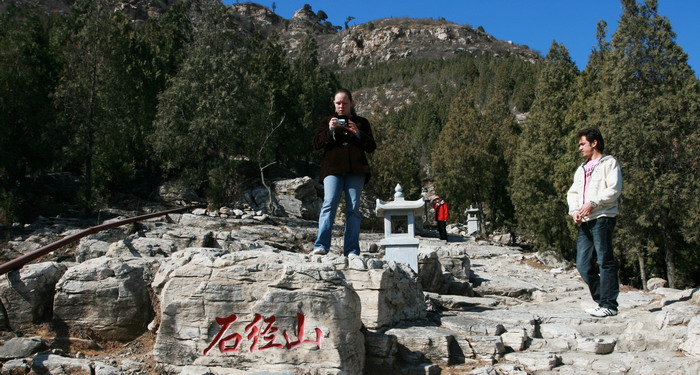
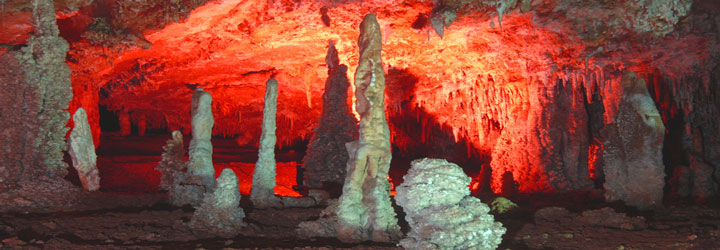
 BOOK IT
BOOK IT ENQUIRY
ENQUIRY